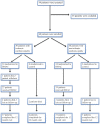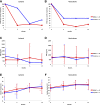REVIVE Trial: Retrograde Delivery of Autologous Bone Marrow in Patients With Heart Failure
- PMID: 26217065
- PMCID: PMC4542877
- DOI: 10.5966/sctm.2015-0070
REVIVE Trial: Retrograde Delivery of Autologous Bone Marrow in Patients With Heart Failure
Abstract
Cell therapy is an evolving option for patients with end-stage heart failure and ongoing symptoms despite optimal medical therapy. Our goal was to evaluate retrograde bone marrow cell delivery in patients with either ischemic heart failure (IHF) or nonischemic heart failure (NIHF). This was a prospective randomized, multicenter, open-label study of the safety and feasibility of bone marrow aspirate concentrate (BMAC) infused retrograde into the coronary sinus. Sixty patients were stratified by IHF and NIHF and randomized to receive either BMAC infusion or control (standard heart failure care) in a 4:1 ratio. Accordingly, 24 subjects were randomized to the ischemic BMAC group and 6 to the ischemic control group. Similarly, 24 subjects were randomized to the nonischemic BMAC group and 6 to the nonischemic control group. All 60 patients were successfully enrolled in the study. The treatment groups received BMAC infusion without complications. The left ventricular ejection fraction in the patients receiving BMAC demonstrated significant improvement compared with baseline, from 25.1% at screening to 31.1% at 12 months (p=.007) in the NIHF group and from 26.3% to 31.1% in the IHF group (p=.035). The end-systolic diameter decreased significantly in the nonischemic BMAC group from 55.6 to 50.9 mm (p=.020). Retrograde BMAC delivery is safe. All patients receiving BMAC experienced improvements in left ventricular ejection fraction, but only those with NIHF showed improvements in left ventricular end-systolic diameter and B-type natriuretic peptide. These results provide the basis for a larger clinical trial in HF patients.
Significance: This work is the first prospective randomized clinical trial using high-dose cell therapy delivered via a retrograde coronary sinus infusion in patients with heart failure. This was a multinational, multicenter study, and it is novel, translatable, and scalable. On the basis of this trial and the safety of retrograde coronary sinus infusion, there are three other trials under way using this route of delivery.
Keywords: Cell transplantation; Coronary sinus; Heart failure; Retrograde approach.
©AlphaMed Press.
Figures



References
-
- World Health Organization. Report of the global survey on the progress in national chronic diseases prevention and control. 2007. Available at: http://www.who.int/chp/ncd_capacity/CCS_2005.pdf?ua=1. Accessed April 1, 2015.
-
- Go AS, Mozaffarian D, Roger VL, et al. Executive summary: Heart disease and stroke statistics—2013 Update: A report from the American Heart Association. Circulation. 2013;127:143–152. - PubMed
-
- Ford ES, Ajani UA, Croft JB, et al. Explaining the decrease in U.S. deaths from coronary disease, 1980-2000. N Engl J Med. 2007;356:2388–2398. - PubMed
-
- U.S. Department of Commerce Economics and Statistics Administration U.S. Census Bureau. Age projections. http://www.censusscope.org/us/chart_age.htm. Accessed April 1, 2015.
-
- National Center for Health Care Statistics. http://www.cdc.gov/nchs. Accessed April 1, 2015.
Publication types
MeSH terms
Substances
LinkOut - more resources
Full Text Sources
Other Literature Sources
Medical
Research Materials
Miscellaneous

